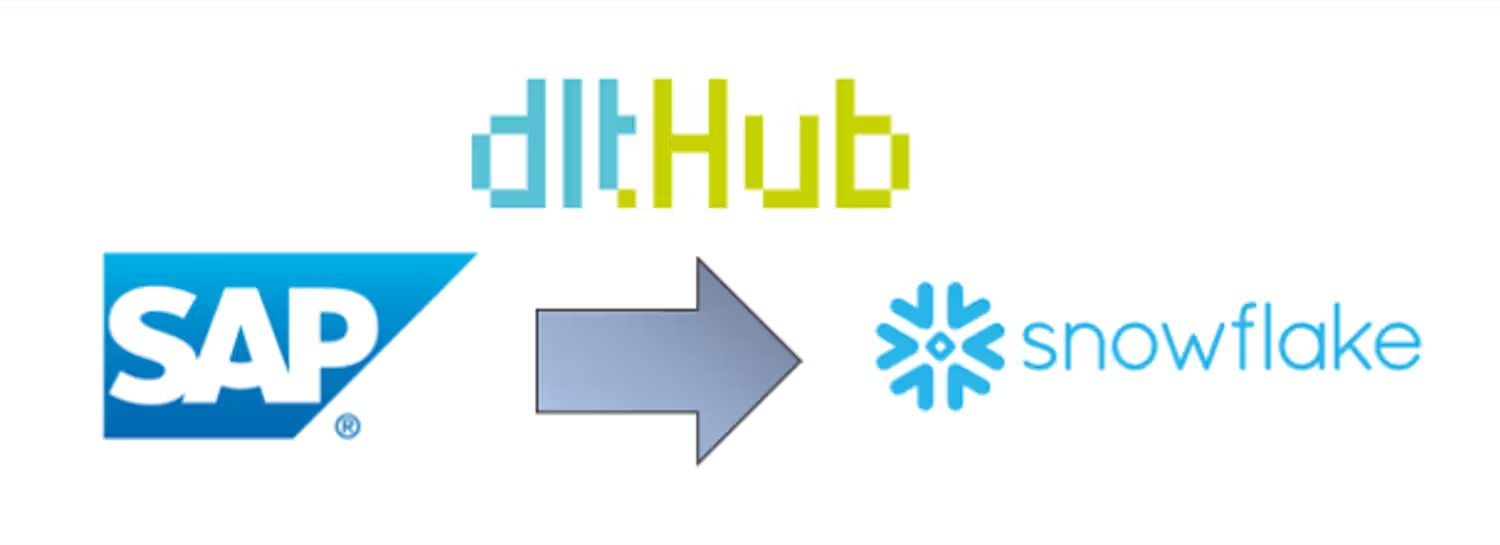Exploring data replication of SAP HANA to Snowflake using dlt
 Rahul Joshi,
Rahul Joshi,
Jr. Solutions Engineer

In case you haven’t figured it out already, we at dltHub love creating blogs and demos. It’s fun, creative, and gives us a chance to play around with many new tools. We are able to do this mostly because, like any other modern tooling, dlt just fits in the modern ecosystem. Not only does dlt have existing integrations (to, for example, GCP, AWS, dbt, airflow etc.) that can simply be “plugged in”, but it is also very simple to customize it to integrate with almost any other modern tool (such as Metabase, Holistics, Dagster, Prefect etc.).
But what about enterprise systems like SAP? They are, after all, the most ubiquitous tooling out there: according to SAP data, 99 out of 100 largest companies are SAP customers. A huge part of the reason for this is that their ERP system is still the gold standard in terms of effectivity and reliability. However, when it comes to OLAP workloads like analytics, machine learning, predictive modelling etc., many companies prefer the convenience and cost savings of modern cloud solutions like GCP, AWS, Azure, etc..
So, wouldn’t it be nice to be able to integrate SAP into the modern ecosystem?
Unfortunately, this is not that simple. SAP does not integrate easily with non-SAP systems, and migrating data out from SAP is complicated and/or costly. This often means that ERP data stays separate from analytics data.
Creating a dlt integration
Our users have been asking for SAP HANA data, hence I decided to create a custom dlt integration to SAP’s in-memory data warehouse: SAP HANA. Given its SQL backend and Python API, I figured dlt should also have no problem connecting to it.
I then use this pipeline to load SAP HANA tables into Snowflake, since Snowflake is cloud agnostic and can be run in different environments (such AWS, GCP, Azure, or any combination of the three). This is how I did it:
Step 1: I created an instance in SAP HANA cloud.
(I used this helpful tutorial to navigate SAP HANA.)

Step 2: I inserted some sample data.

Step 3: With tables created in SAP HANA, I was now ready to create a dlt pipeline to extract it into Snowflake:
Since SAP HANA has a SQL backend, I decided to extract the data using dlt’s SQL source
- I first created a dlt pipeline
dlt init sql_database snowflake - I then passed the connection string for my HANA instance inside the loading function in
sql_database_pipeline.py. (Optional: I also specified the tables that I wanted to load insql_database().with_resources("v_city", "v_hotel", "room")) - Before running the pipeline I installed all necessary requirements using
pip install -r requirements.txtThe dependencies insiderequirements.txtare for the general SQL source. To extract data specifically from HANA, I also installed the packageshdbcliandsqlalchemy-hana.
Step 4: I finally ran the pipeline using python sql_database_pipeline.py. This loaded the tables into Snowflake.

Takeaway
The dlt SAP HANA connector constructed in this demo works like any other dlt connector, and is able to successfully load data from SAP HANA into data warehouses like Snowflake.
Furthermore, the demo only used a toy example, but the SQL source is a production-ready source with incremental loading, merges, data contracts etc., which means that this pipeline could also be configured for production use-cases.
Finally, the dlt-SAP integration has bigger consequences: it allows you to add other tools like dbt, airflow etc. easily into an SAP workflow, since all of these tools integrate well with dlt.
Next steps
This was a just first step into exploring what’s possible. Creating a custom dlt connector worked pretty well for SAP HANA, and there are several possible next steps, such as converting this to a verified source, or building other SAP connectors.
- Creating a verified source for SAP HANA: This should be pretty straight-forward since it would require a small modification of the existing SQL source.
- Creating a dlt connector for SAP S/4 HANA: S/4 HANA is SAP’s ERP software that runs on the HANA database. The use case would be to load ERP tables from S/4 HANA into other data warehouses like Snowflake. Depending on the requirements, there are two ways to go about it:
- Low volume data: This would again be straight-forward. SAP offers REST API end points to access ERP tables, and dlt is designed to be able to load data from any such end point.
- High volume data: dlt can also be configured for the use case of migrating large volumes of data with fast incremental or merge syncs. But this would require some additional steps, such as configuring the pipeline to access HANA backend directly from Python hdbcli.